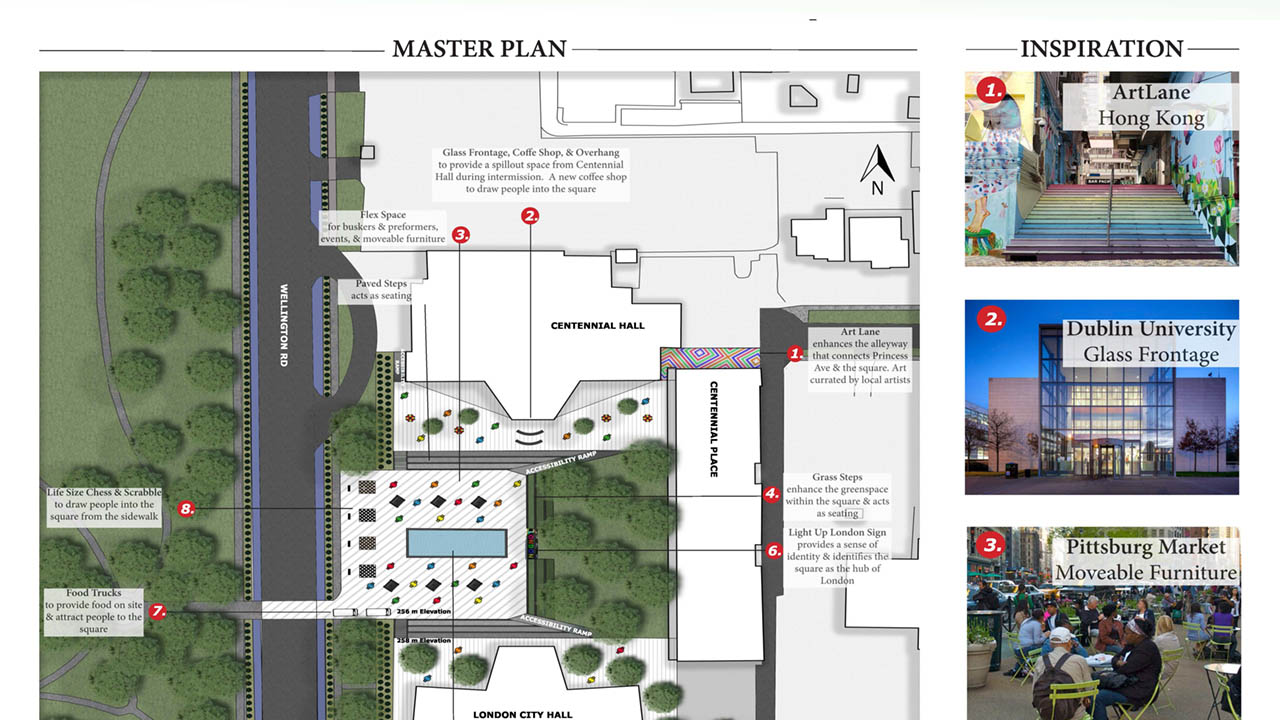Fanshawe wins annual TD Environmental Design Competition
 CREDIT: COURTESY OF WILLIAM POL
CREDIT: COURTESY OF WILLIAM POLSecond-year Honours Bachelor of Environmental Design and Planning student Sarah Ashman, won first place in the Landscape Design category for her plan for Reginald Cooper Square.
In a competition alongside their peers from Aeres University in the Netherlands, six groups of Fanshawe students competed in the annual TD Environmental Design Competition.
The online event, presented by TD Bank Group, took place on March 26 and challenged the teams to create urban designs that reflect “Growing Green Cities” with food production, healthiness and renewable energy production.
Fanshawe Professor William Pol of the GIS and Urban Planning program coordinated the competition and shared in the excitement with attendees of the event.
“The students are assigned the project in class and the professors work with them to respond to the problem. That’s on the landscape side, they work through it in the classroom. For the urban design side, we take the students out of the classroom for a week, and they do a charette. It’s a bit of a different process on the urban design versus the landscape side.”
Fanshawe’s entries are developed by students from the GIS and Urban Planning in addition to the Honours Bachelor of Environmental Design and Planning programs. With a focus on the theme of sustainable redevelopment, Reginald Cooper Square, located behind London’s City Hall, and the seven-hectare footprint of the former cereal factory at 100 Kellogg Lane were the student’s centres of attention.
In judging the competition, Pol noted what students need to emphasize to stand out with their completed entry.
“There’s three parts that the judges are asked to look at. One is the inspirational piece; does the design inspire you to build this project or create this project? Secondly, does it meet the Growing Green City’s objectives? Are there parts of the design that add greenery? Are there parts of the design that perhaps feed the community? And the third, does the design fit into the context of the site? Does it make sense relative to surrounding land uses surrounding buildings? Does it connect to the surrounding area with sidewalks, bike paths, and public transit?”
Second-year Honours Bachelor of Environmental Design and Planning student Sarah Ashman, won first place in the Landscape Design category for her plan for Reginald Cooper Square.
“This was my first time presenting my work outside of the classroom and while it was certainly nerve-wracking, it was an amazing experience,” she said. “It’s important that we explore Growing Green Cities because our generation is at the forefront of the climate change crisis. As planners, designers and analysts, we will be responsible for how our cities grow and adapt to these changes.”
In response to Fanshawe’s winning entry, Pol congratulated the design Ashman created for the competition.
“She had a very good response to the contest,” said Pol. “This particular Reg Cooper Square is sort of a very unfriendly, uninviting space behind City Hall. With her design, she really transformed the space by adding more activities, making it pedestrian and more people friendly, and transforming it from a sort of dead, uninviting space to a vibrant people square. Opening up the buildings onto the square, creating seating areas, creating green space that invite people to stay for a much longer time as opposed to what the space looks like now.”
Winners of first place in the Urban Design category for Connect Green included Alex Robinson, Danieli Sikelero Elsenbruch, Duc Nguyen, Jeongsuk Jang and Patricia Dunajski from the GIS and Urban Planning program.
“Their emphasis is focused on renewable energy greening up Kellogg Lane because it was a former industrial site,” said Pol. “So they’re really emphasizing landscaping, adding trees, opening up the paved area to more grass. That was the one element, and the second element is with respect to connecting Kellogg Lane to the surrounding area. It’s not sort of accessible to the wider community. So, Connect Green was really trying to emphasize the bus transit that’s along Dundas Street. That was an opportunity they saw. It also added a lot more pedestrian friendly and cycling friendly features to the site to connect it to the rest of London.”
Hinting at the excitement for future TD Environment Design competitions, Pol noted there is an excellent opportunity for students across the campus to complete their SILEx (Signature Innovative Learning Experience). Students will then take their ideas and concepts learned in the classroom, and then apply them to real life situations.
“We look forward to students from across campus participating in next year’s project.”

















